Probiotic-rich fermented cabbage with caraway seeds (Traditional German Sauerkraut)
With its tangy flavours, this probiotic-rich fermented cabbage with caraway seeds is the traditional German sauerkraut. Try it as a delicious topping on sandwiches and bowls, or as a side with your everyday dinner.
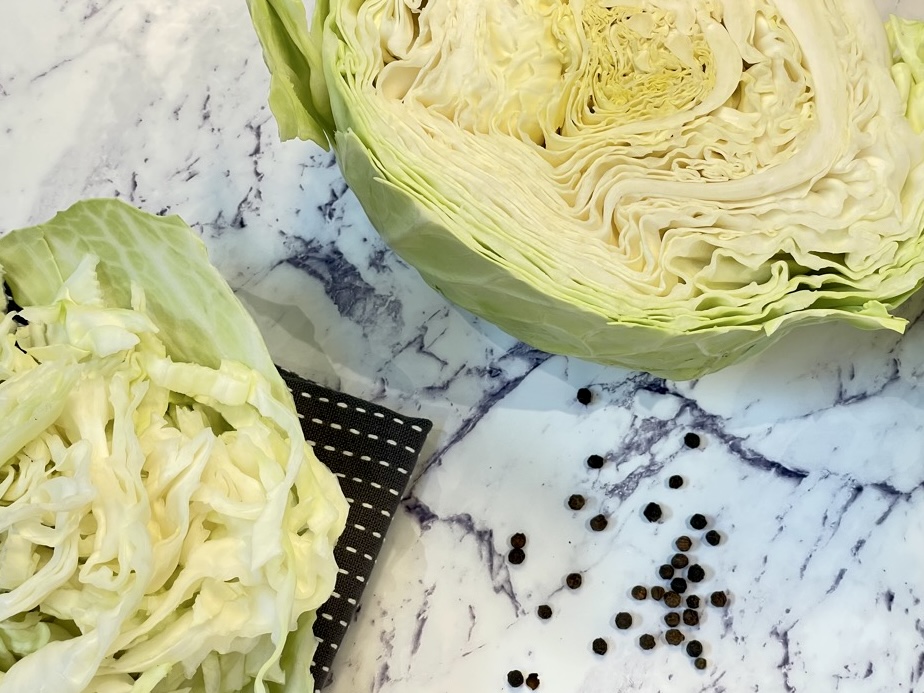
Ever wondered how a jar of sauerkraut can cost you $10 at your local grocery store? Surely it must be incredibly difficult to make, right? Wrong. This probiotic-rich fermented cabbage with caraway seeds (also known as the traditional German sauerkraut) is one of the easiest things you have ever made. Spending a few minutes chopping a head of cabbage and rubbing it with salt will be the game changer your life needed. Goodbye steep grocery bills, hello organic sauerkraut.
Sauerkraut is one of those dishes that, up until the hipster era began, seemed to only be popular in German speaking countries. Where I grew up in Southern Germany, sauerkraut is served hot with most meat and dumpling dishes. Even as a youngster, I can‘t recall a moment where my taste buds didn‘t love this German food. While we serve it hot to combat the cool temperatures of winter and boost our immune system, the currently more popular version of this traditional dish calls to be cooled and added as a crunchy topping or side.
Probiotic-rich fermented cabbage with caraway seeds is the perfect easy recipe for those new to fermented food. Using only a few common household ingredients, a pound of cabbage transforms to a beautifully fragrant jar of Bavarian style sauerkraut in a matter of days. The best thing is, once placed in a jar, this fuss-free cabbage needs no love at all and can be stored at room temperature until ready.
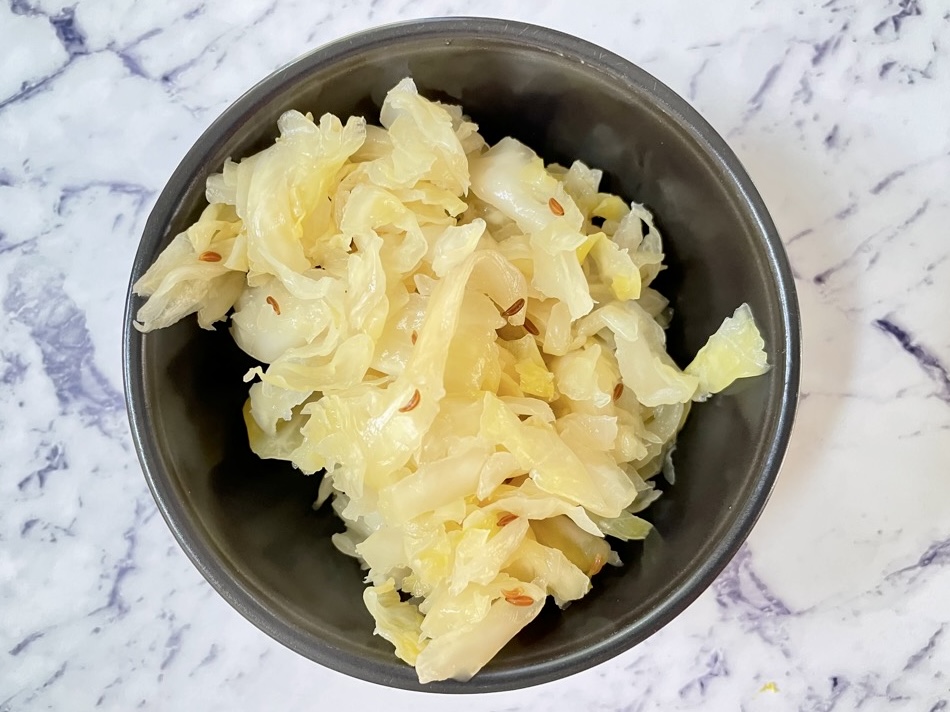
What you‘ll need to make probiotic-rich fermented cabbage with caraway seeds (Traditional German Sauerkraut)
A head of white cabbage of course. If possible, try and buy an organic one for your extra special sauerkraut. Even if it‘s a little more than the non-organic one, think about how much 1-2kg jars of organic sauerkraut would cost you. It‘s worth it to splurge on the good stuff!
Salt – the magic ingredient for any favorite recipe. Salt allows the cabbage to safely ferment and will preserve instead of rot your sour cabbage.
Caraway seeds – as suggested in the heading. In the South of Germany, you‘ll find caraway seeds spread across a wide range of recipes. We even have a traditional bread roll covered in them, called a Briegel. Delicious, and yet another way to integrate rare spices in your diet.
Pepper corns – a little goes a long way. I‘ve made the mistake of adding far too many in the past, and it honestly ruined the dish.
A large glass jar which can hold the entire chopped cabbage. Make sure the jar you choose can accommodate a weight, which will be placed on top of the cabbage to keep it submerged.
A weight to place into the jar to keep the cabbage submerged in its liquids. If you‘re crafty like me and don’t want to spend more money on kitchen gadgets, grab a small dumbbell, wrap it in plastic and use it to keep your cabbage „under water“. Another option is to fill a clean glass vase with water to keep the cabbage submerged.
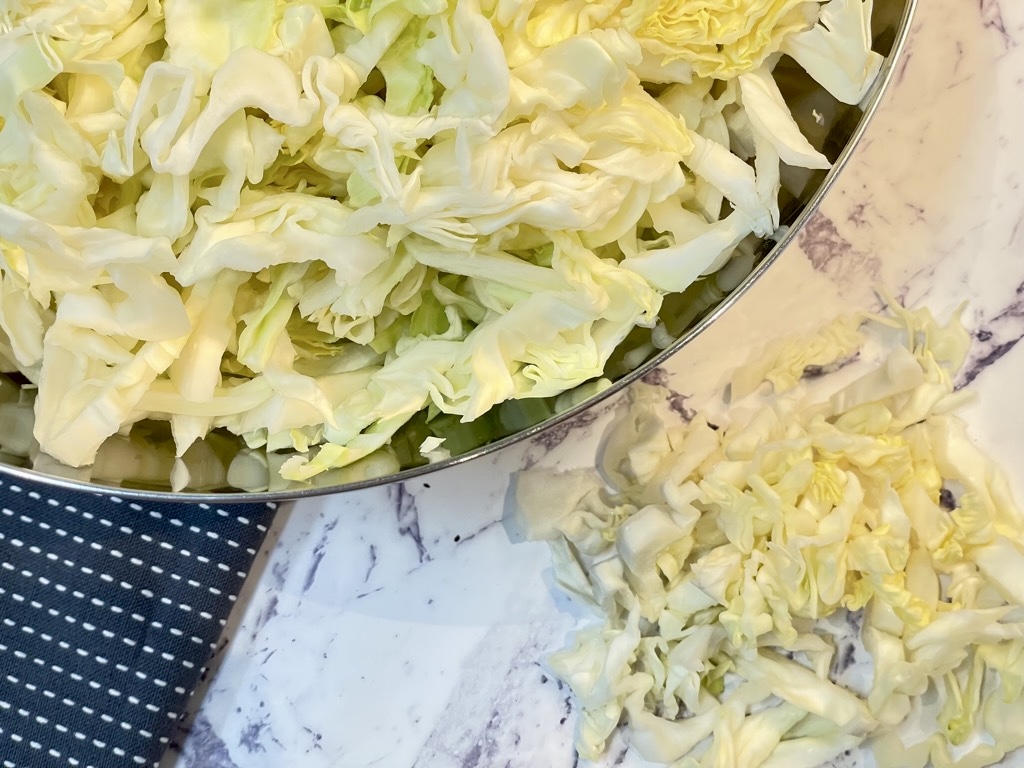
How to make Probiotic-rich fermented cabbage with caraway seeds (Traditional German Sauerkraut)
Even though we‘re using organic produce, let‘s remove the outer leaves of our cabbage. One layer is usually enough, just make sure there are no bugs hidden under the remaining layers.
Next, grab a large bowl, a sharp knife and the biggest cutting board your kitchen has to give. It‘s time to shred the cabbage. We want to create fine strips of cabbage, which sounds simple, but can become a little tricky as the cabbage leaves move around.
If you want to give your cabbage a quick rinse, go for it. Just hold the whole head under water and pat it dry once rinsed. Cut your cabbage into quarters. Using one quarter at a time, finely slice the cabbage. I like to secure the quarters by firmly holding them by the remaining stalks, as this keeps the quarters from slipping too much.
As your chopping board fills up, transfer the cabbage shreds into your large bowl. Keep going until all cabbage is shredded, discarding the stalk.
Now it‘s time to massage. Add teaspoons of salt to your cabbage. Rub the salt into the cabbage as if you were giving it a massage. We want to keep massaging until the cabbage becomes soft and starts to swim in its own juices. This process will take between 5 and 10 minutes and is the perfect time to catch up on your favourite tv show.
Once the cabbage has been thoroughly massaged, add the pepper corns and caraway seeds and give it a good mix.
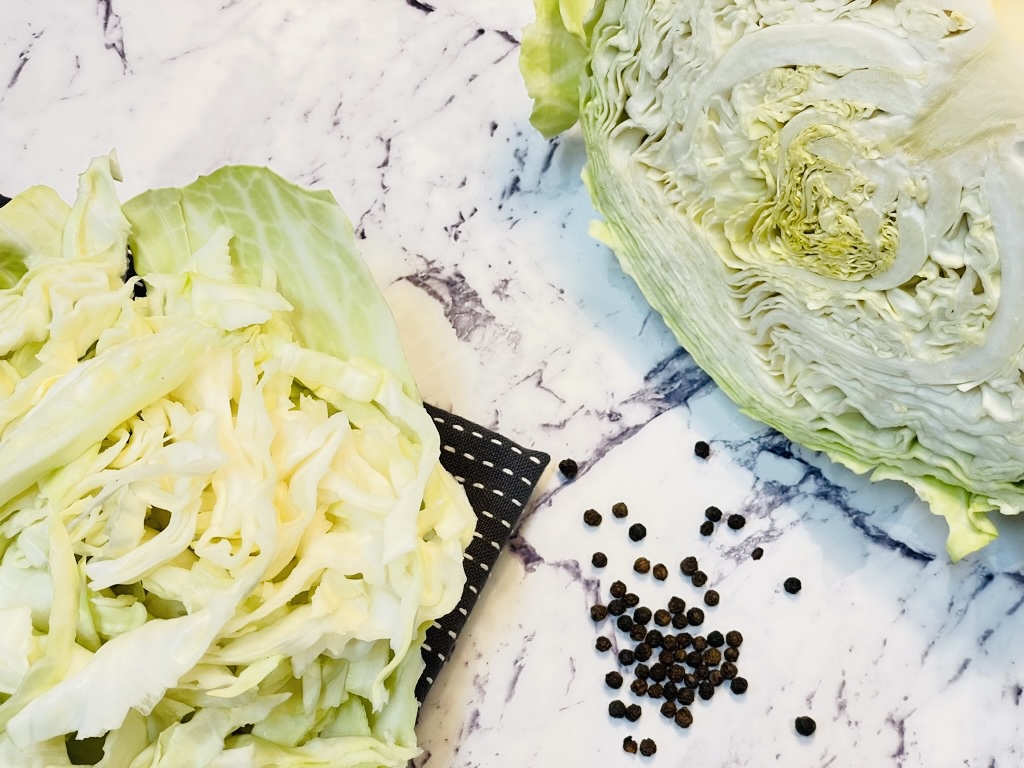
Ready to ferment
Transfer the sliced cabbage mixture with all its juices into a large glass jar. Make sure there is enough brine to submerge your cabbage when pressed down. If you don‘t have enough liquid yet, keep massaging the cabbage for a little longer.
Place fermentation weights on top of your shredded cabbage to keep it below water level. I am currently using a clean glass vase filled with water, but have used a dumbbell wrapped in plastic in the past. Whatever you use, make sure it‘s clean to prevent mold growth.
Lastly, wrap a clean tea towel around the top of your jar to protect the cabbage from whatever flies or splatters around your kitchen, while still allowing it to breathe.
Allow the cabbage to ferment in a dark place on your kitchen counter, away from direct sunlight. Fermentation will depend on your kitchen‘s temperatures. In most areas, your sauerkraut should be ready after about a week. You can start to taste a little and see if you like the flavour. A good indicator is to monitor the bubbling on top of the jar. Once it subsides, your sauerkraut is ready.
Store your sauerkraut in the fridge or cool place and keep serving it with lunch or dinner.

What to serve with Probiotic-rich fermented cabbage with caraway seeds (Traditional German Sauerkraut)
Sauerkraut is one of those dishes that can be served with almost anything. For us Germans, it‘s a traditional side to roast dinners of meat and dumplings. We usually heat it up and even mix it with pineapple, for a sweeter, more exotic flavour. Sounds horrendous, is delicious!
For a more casual approach on traditional German sauerkraut, serve it with rustic sourdough and your favourite toppings. You can add it to salads, or as a side to your roasted potatoes or carrots. Whatever you do, you‘ll love how much better it makes your tummy feel after a filling meal.
More favourite rustic recipes
Classic almond flour shortbread biscuits
High protein spiced sweet potato soup
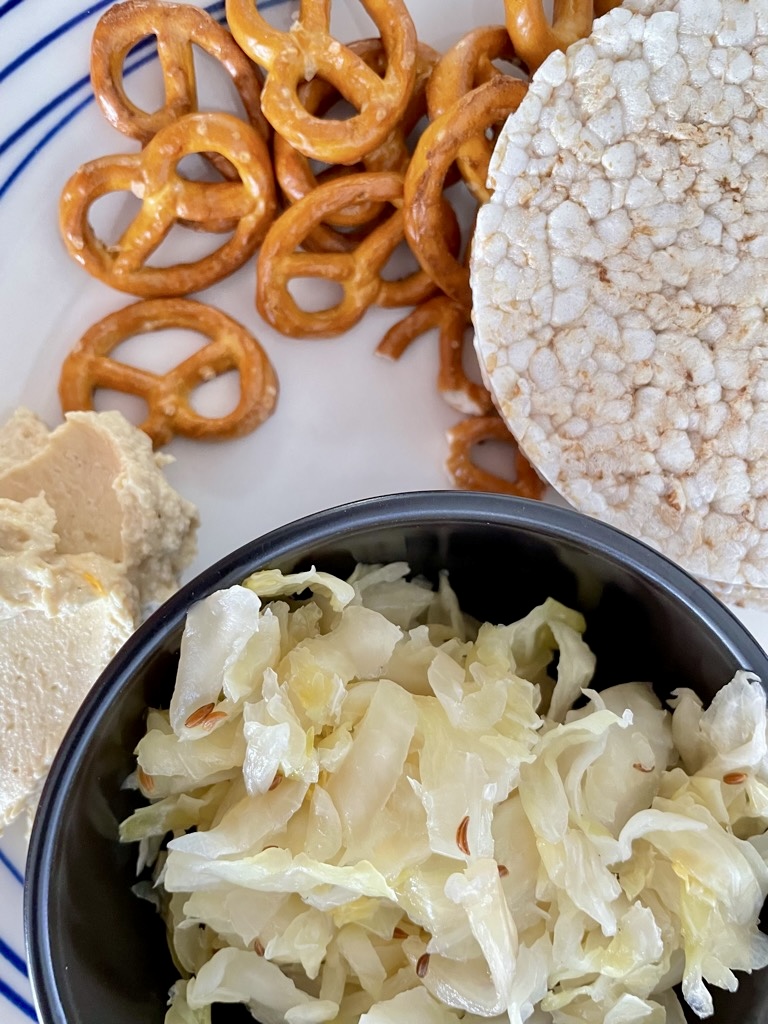
Frequently asked questions
Why do they put caraway seeds in sauerkraut?
Caraway seeds are a traditional spice we use in German cuisine. It adds a tasty, unique flavour to not only cabbage but also baked goods. The tasty little seeds promote digestive health and are an ideal partner to add to the probiotic sauerkraut. Coincidentally, they are also anti-fungal and help keep mould and other nasty‘s at bay while your sauerkraut goes through the fermentation process.
What is the difference between sauerkraut and German sauerkraut?
Sauerkraut is a popular dish you will find native to numerous countries across central and Eastern Europe. With cabbage being an easy to grow, and even easier to store vegetable, many of our ancestors have developed traditional dishes around it. Sauerkraut in its basic form is native to many countries, Germany included. What you will find is that the addition to the kraut is however more localised to individual countries. Germany for example of then uses caraway seeds or juniper berries in both their hot and cold sauerkraut. Polish sauerkraut often adds carrots to the kraut, giving the final product a slightly sweeter flavour. In most cases, finding the right recipe for you is a matter of flavour preferences and testing a few traditional German recipes.
Can you eat sauerkraut every day?
Yes, sauerkraut can be eaten daily. The probiotic-rich cabbage is great for supporting gut health. Saying this, keep in mind that many other fermented foods such as kimchi, kombucha and yoghurt, all have different sets of probiotics. While homemade sauerkraut is a great food to add to your diet, it‘s always recommended to cover your nutritional intake with a variety of foods. Introducing a range of probiotic-rich foods which can be mixed up throughout the week is therefore a great idea.
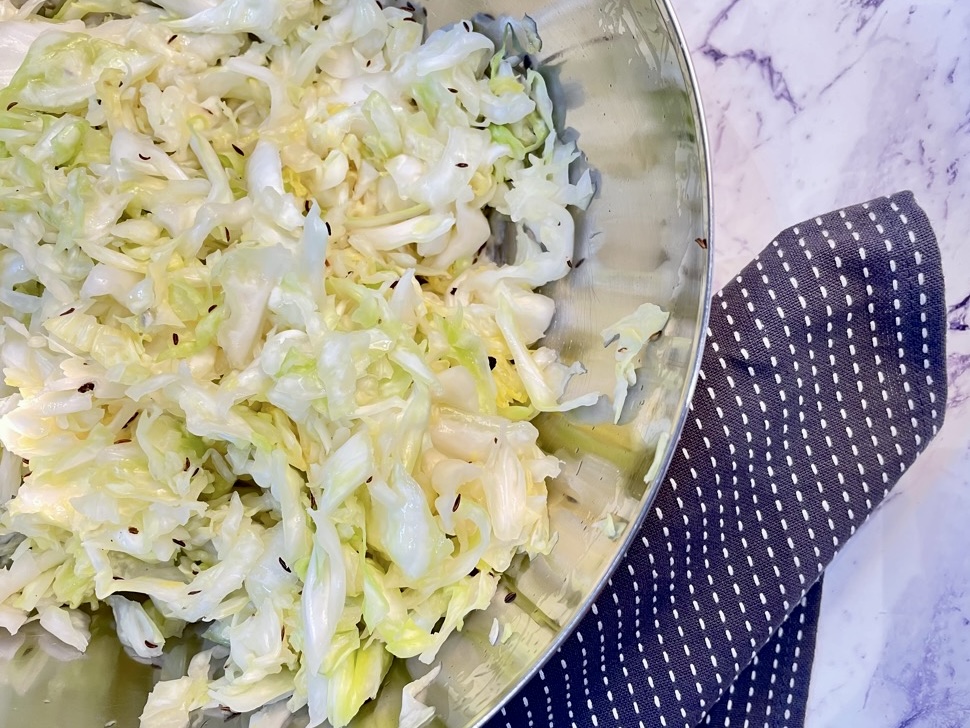
Is sauerkraut better than probiotic pills?
Personally, I support real food over pills any day of the week. Our bodies have been designed to absorb nutrients from food. The way I look at it, eating a well-balanced diet trumps junk food and supplements. Saying this, not all bodies are and work the same. These days, many of us struggle with digestive issues, making it difficult to absorb the nutrients we try to feed ourselves. While this doesn‘t support the junk food, it may be one of those cases where sauerkraut plus probiotic pills are the best choice for yourself, ensuring your body can absorb what it needs from a variety of sources.
Is it ok to eat sauerkraut by itself?
Yes, absolutely. Sauerkraut is delicious and can be enjoyed by itself, either raw or cooked. My personal favourites for enjoying my own sauerkraut are either hot, and mixed with pineapple, or cold piled high onto crackers with hummus. It‘s one of those low calorie dishes that adds tons of flavours to whatever you serve it with. So while I still snack on my sauerkraut by itself, I much prefer to add it to another few staples and create a full meal from it.
What is a substitute for caraway seeds in sauerkraut?
The closest substitute for caraway seeds are usually fennel seeds. In most cases, you will find very little difference in flavours when substituting, which is of course what we‘re after. Both caraway and fennel seeds can usually be found in your local supermarket and are easy to store for long periods of time. Should neither option be available to you, anise seeds may have a similar effect, but will need to be used in lesser quantities to not overpower your dish.
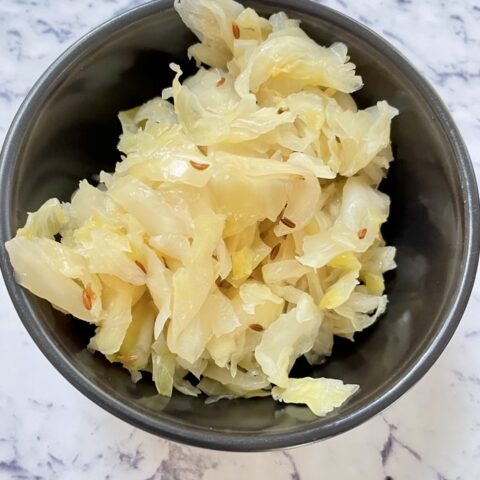
Probiotic-rich fermented cabbage with caraway seeds (Traditional German Sauerkraut)
Try it as a delicious topping on sandwiches and bowls, or as a side with your everyday dinner.
Ingredients
- 1 head of white cabbage, about 1kg
- 1.5 tsp salt
- 1tsp caraway seeds
- 10-15 pepper corns
Instructions
- Even though we‘re using organic produce, let‘s remove the outer leaves of our cabbage. One layer is usually enough, just make sure there are no bugs hidden under the remaining layers.
- Next, grab a large bowl, a large knife and the biggest chopping board your kitchen has to give. It‘s time to shred the cabbage. We want to create fine strips of cabbage, which sounds simple, but can become a little tricky as the cabbage leaves move around.
- If you want to give your cabbage a quick rinse, go for it. Just hold the whole head under water and pat it dry once rinsed. Cut your cabbage into quarters. Using one quarter at a time, finely slice the cabbage. I like to secure the quarters by firmly holding them by the remaining stalks, as this keeps the quarters from slipping too much.
- As your chopping board fills up, transfer the cabbage shreds into your large bowl. Keep going until all cabbage is shredded, discarding the stalk.
- Now it‘s time to massage. Add salt to your cabbage. Rub the salt into the cabbage as if you were giving it a massage. We want to keep massaging until the cabbage becomes soft and starts to swim in its own juices. This process will take between 5 and 10 minutes and is the perfect time to catch up on your favourite tv show.
- Once the cabbage has been thoroughly massaged, add the pepper corns and caraway seeds and give it a good mix.
- Transfer the cabbage mixture with all its juices into a large glass jar. Make sure there are enough juices to submerge your cabbage when pressed down. If you don‘t have enough liquid yet, keep massaging the cabbage for a little longer.
- Place a weight on top of your cabbage to keep it submerged under its juices. I am currently using a clean glass vase filled with water, but have used a dumbbell wrapped in plastic in the past. Whatever you use, make sure it‘s clean.
- Lastly, wrap a clean tea towel around the top of your jar to protect the cabbage from whatever flies or splatters around your kitchen, while still allowing it to breathe.
- Allow the cabbage to ferment on your kitchen bench, away from the sun. Fermentation will depend on your kitchen‘s temperatures. In most areas, your sauerkraut should be ready after about a week.
- Store your sauerkraut in the fridge and keep serving it with lunch or dinner.
Notes
A good indicator of your sauerkraut being ready is to monitor the bubbling on top of the jar. Once it subsides, your sauerkraut is ready.
Fermentation will depend on your kitchen‘s temperatures. In most areas, your sauerkraut should be ready after about a week.
